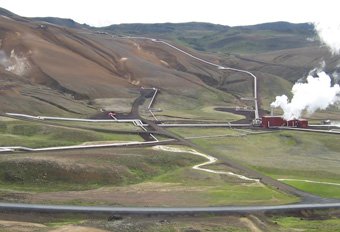When tested, the magma well produced dry steam at 750 degrees Fahrenheit , enough to generate up to 25 megawatts of electricity, which could power 25,000 to 30,000 homes. Fine, fine, but what does that mean? Only 5 to 8 megawatts are produced by a typical geothermal well, and Iceland already gets about one-third of its electricity and almost all of its home heating from geothermal sources, but this is a terrific new source.
The team was drilling into the Krafla caldera as part of the Iceland Deep Drilling Project, an industry-government consortium, to test whether "supercritical" water, very hot water under very high pressure, could be exploited as a source of power.

Geothermal field at Krafla, Iceland. Photo: Peter Schiffman/UC Davis
They planned to drill to 15,000 feet but at 6,900 feet, magma (molten rock from the Earth's core) flowed into the well, forcing them to stop. The composition of magma from the borehole is also providing insight into how magmas form beneath Iceland, said Peter Schiffmann, professor of geology at UC Davis and a member of the research team.
A paper describing geological results from the well will published this month in the journal Geology.






Comments